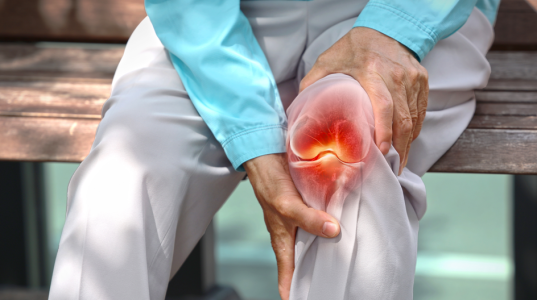Suffering from knee pain? Discover the surprising non-surgical solutions to osteoarthritis relief!
By
Gian T
- Replies 1
As we age, our bodies inevitably undergo changes, and for many Australians over 60, knee pain from osteoarthritis can become a daily struggle. The discomfort and mobility issues associated with this condition can significantly impact one's quality of life. However, recent updates from the Australian Commission on Safety and Quality in Health Care suggest that surgery might not be the only answer for those suffering from knee osteoarthritis. In fact, there are several non-surgical methods that can provide relief and improve mobility.
Understanding Knee Osteoarthritis
Osteoarthritis is a condition that affects over 2 million Australians, not only in the knees but also in the hips, spine, hands, and feet. It involves the entire joint, including bone, cartilage, ligaments, and muscles. The persistent pain and difficulty in performing daily tasks like walking and climbing stairs can be debilitating.
Contrary to the common belief that osteoarthritis is simply a result of 'wear and tear', research has shown that the degree of structural changes seen on an X-ray doesn't always match the level of pain or disability experienced. This means that X-rays aren't necessary for diagnosing the condition or guiding treatment decisions. Moreover, using the term 'wear and tear' can instil unnecessary fear and lead to invasive treatments, such as surgery, that might not be needed.
Non-Surgical Treatments for Osteoarthritis
The good news is that non-surgical treatments have been proven effective for most people with osteoarthritis, regardless of age or symptom severity. These treatments include:
1. Education and Self-Management: Understanding what osteoarthritis is, how it's diagnosed, and its prognosis is crucial. Dispelling misconceptions and being informed about self-management techniques can empower individuals to take control of their symptoms.
2. Exercise and Physical Activity: Many fear that exercise will worsen their condition, but safe and appropriate physical activity can actually reduce pain and disability. Strength training, aerobic exercises, yoga, and tai chi are all beneficial. It's about finding the type of exercise that suits you best and integrating more physical activity into your daily routine.
3. Weight Management and Nutrition: For those who are overweight or obese, weight loss can significantly reduce knee pain and disability. Even a modest reduction of 5–10% of body weight can have a positive impact, especially when combined with exercise.
4. Pain Medicines: While they should not replace other treatments, certain pain medicines can be used to manage pain alongside exercise and weight management. Paracetamol and non-steroidal anti-inflammatory drugs are recommended, but opioids are not due to their potential for harm.
Surgery: A Last Resort?
While knee arthroscopy and knee replacement are common surgical procedures for osteoarthritis, they are not always necessary or effective. Arthroscopy, for instance, has been shown to be ineffective for osteoarthritis management. Joint replacement should only be considered for those with severe symptoms who have not found relief through non-surgical treatments.
Taking Action Against Knee Osteoarthritis
If you're dealing with knee osteoarthritis, there are free evidence-based resources available to support you, including online education courses, self-directed exercise and yoga programs, weight management support, and pain management strategies like MyJointPain and painTRAINER.
It's important to use these resources to inform discussions with your healthcare provider and make informed decisions about your care. Remember, you have options beyond surgery, and with the right approach, you can manage your symptoms and maintain an active, fulfilling life.
 We'd love to hear from our readers about their experiences with knee osteoarthritis. Have you found non-surgical methods that work for you? Share your stories in the comments below, and let's support each other in finding relief and staying active!
We'd love to hear from our readers about their experiences with knee osteoarthritis. Have you found non-surgical methods that work for you? Share your stories in the comments below, and let's support each other in finding relief and staying active!
Understanding Knee Osteoarthritis
Osteoarthritis is a condition that affects over 2 million Australians, not only in the knees but also in the hips, spine, hands, and feet. It involves the entire joint, including bone, cartilage, ligaments, and muscles. The persistent pain and difficulty in performing daily tasks like walking and climbing stairs can be debilitating.
Contrary to the common belief that osteoarthritis is simply a result of 'wear and tear', research has shown that the degree of structural changes seen on an X-ray doesn't always match the level of pain or disability experienced. This means that X-rays aren't necessary for diagnosing the condition or guiding treatment decisions. Moreover, using the term 'wear and tear' can instil unnecessary fear and lead to invasive treatments, such as surgery, that might not be needed.
Non-Surgical Treatments for Osteoarthritis
The good news is that non-surgical treatments have been proven effective for most people with osteoarthritis, regardless of age or symptom severity. These treatments include:
1. Education and Self-Management: Understanding what osteoarthritis is, how it's diagnosed, and its prognosis is crucial. Dispelling misconceptions and being informed about self-management techniques can empower individuals to take control of their symptoms.
2. Exercise and Physical Activity: Many fear that exercise will worsen their condition, but safe and appropriate physical activity can actually reduce pain and disability. Strength training, aerobic exercises, yoga, and tai chi are all beneficial. It's about finding the type of exercise that suits you best and integrating more physical activity into your daily routine.
3. Weight Management and Nutrition: For those who are overweight or obese, weight loss can significantly reduce knee pain and disability. Even a modest reduction of 5–10% of body weight can have a positive impact, especially when combined with exercise.
4. Pain Medicines: While they should not replace other treatments, certain pain medicines can be used to manage pain alongside exercise and weight management. Paracetamol and non-steroidal anti-inflammatory drugs are recommended, but opioids are not due to their potential for harm.
Surgery: A Last Resort?
While knee arthroscopy and knee replacement are common surgical procedures for osteoarthritis, they are not always necessary or effective. Arthroscopy, for instance, has been shown to be ineffective for osteoarthritis management. Joint replacement should only be considered for those with severe symptoms who have not found relief through non-surgical treatments.
Taking Action Against Knee Osteoarthritis
If you're dealing with knee osteoarthritis, there are free evidence-based resources available to support you, including online education courses, self-directed exercise and yoga programs, weight management support, and pain management strategies like MyJointPain and painTRAINER.
It's important to use these resources to inform discussions with your healthcare provider and make informed decisions about your care. Remember, you have options beyond surgery, and with the right approach, you can manage your symptoms and maintain an active, fulfilling life.
Key Takeaways
- Most individuals with knee osteoarthritis can manage their pain and improve mobility without resorting to surgery, according to new treatment guidelines from the Australian Commission on Safety and Quality in Health Care.
- Knee osteoarthritis, which affects over 2 million Australians, is not simply due to 'wear and tear', and X-rays are not always indicative of pain levels or necessary for treatment decisions.
- Recommended non-surgical treatments include education about the condition, self-management, regular exercise and physical activity, weight management and nutrition, as well as specific pain medications, but not opioids.
- The updated guidelines suggest considering surgery, such as knee arthroscopy or joint replacement, only after non-surgical treatments have been tried and for those with severe symptoms.








